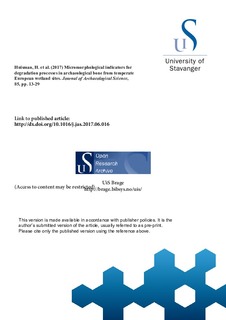| dc.contributor.author | Huisman, Hans | |
| dc.contributor.author | Ismail-Meyer, Kristin | |
| dc.contributor.author | Sageidet, Barbara Maria | |
| dc.contributor.author | Joosten, Ineke | |
| dc.date.accessioned | 2018-03-01T10:07:41Z | |
| dc.date.available | 2018-03-01T10:07:41Z | |
| dc.date.created | 2017-10-31T15:16:39Z | |
| dc.date.issued | 2017 | |
| dc.identifier.citation | Huisman, H. et al. (2017) Micromorphological indicators for degradation processes in archaeological bone from temperate European wetland sites. Journal of Archaeological Science. 85, 13-29. | nb_NO |
| dc.identifier.issn | 0305-4403 | |
| dc.identifier.uri | http://hdl.handle.net/11250/2487900 | |
| dc.description.abstract | Micromorphological investigations of archaeological bones make it possible to study decay processes and the associated depositional environment in one go. A selection of micromorphological thin sections from soil samples from three wetland sites in Switzerland, The Netherlands and Norway that contained bone fragments were studied. The goal was to investigate the type and the timing of decay processes to better understand the taphonomy of bones in such sites. Using optical microscopy and scanning electron microscopy with energy dispersive X-ray spectroscopy (SEM-EDX), a range of biological decay processes and chemical/mineralogical transformations were observed. In two of the sites e Zug-Riedmatt in Switzerland and Hazendonk in The Netherlands e a relatively short exposure to adverse conditions must have occurred: Some of the bones from Zug-Riedmatt show localized collagen decay related to exposure to fresh ashes; others show cyanobacterial tunnelling related to submersion in shallow, clear water. In Hazendonk, bone fragments and fish scales apparently have first been exposed to bacterial decay related to putrefaction. Subsequently, alternations between wet and dry conditions resulted in the dissolution of some of the bone mineral and the formation of Ca, Fe(III) phosphates, probably mitridatite. Fungal decay caused extensive tunnelling of bone and fish scales as well as the secondary phosphates. These processes apparently ended when the bone-rich layer became permanently waterlogged and anoxic. In Stavanger, bone mineral is transformed into mitridatite and possibly other Ca Fe(III) phosphates. Indications that the redox conditions are variable at present suggest that these processes are still active. © | nb_NO |
| dc.language.iso | eng | nb_NO |
| dc.subject | mikromorfologi | nb_NO |
| dc.subject | soil micromorphology | nb_NO |
| dc.subject | arkeologiske avsetninger | nb_NO |
| dc.subject | archaeological deposits | nb_NO |
| dc.subject | geoarkeologi | nb_NO |
| dc.subject | geoarcheology | nb_NO |
| dc.subject | fosfat | nb_NO |
| dc.subject | arkeologi | nb_NO |
| dc.title | Micromorphological indicators for degradation processes in archaeological bone from temperate European wetland sites | nb_NO |
| dc.type | Journal article | nb_NO |
| dc.description.version | submittedVersion | nb_NO |
| dc.rights.holder | © Elsevier | nb_NO |
| dc.subject.nsi | VDP::Stratigrafi og paleontologi: 461 | nb_NO |
| dc.subject.nsi | VDP::Stratigraphy and palaeontology: 461 | nb_NO |
| dc.source.pagenumber | 13-29 | nb_NO |
| dc.source.volume | 85 | nb_NO |
| dc.source.journal | Journal of Archaeological Science | nb_NO |
| dc.identifier.doi | 10.1016/j.jas.2017.06.016 | |
| dc.identifier.cristin | 1509449 | |
| dc.relation.project | Universitetet i Stavanger: IN-10221 | nb_NO |
| cristin.unitcode | 217,6,4,0 | |
| cristin.unitname | Institutt for barnehagelærerutdanning | |
| cristin.ispublished | true | |
| cristin.fulltext | preprint | |
| cristin.qualitycode | 2 | |
